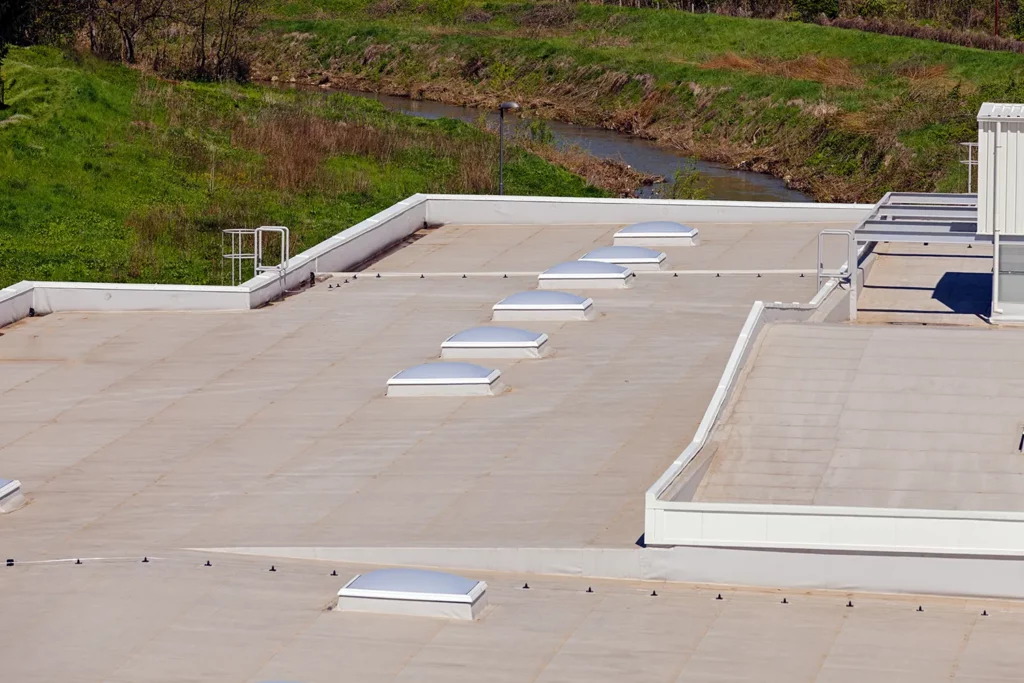When it comes to choosing a roofing material for your flat roof, durability and longevity are top priorities. Flat roofs face unique challenges, including exposure to the elements, potential water pooling, and temperature fluctuations. One roofing option that has gained popularity for its exceptional performance in these conditions is TPO (Thermoplastic Olefin) roofing. In this blog, we’ll explore the enduring qualities of TPO flat roofs and why they have become a favored choice for many property owners.
Understanding TPO Roofing
Before we dive into the durability of TPO flat roofs, let’s take a moment to understand what TPO roofing is. TPO is a single-ply roofing membrane made of a blend of synthetic materials, typically including ethylene-propylene rubber and polypropylene. This combination creates a flexible, heat-reflective, and UV-resistant roofing material that is perfect for flat roofs.
TPO roofing is installed in large, seamless sheets, minimizing the risk of leaks and providing a sleek, clean appearance. Its white or light-colored surface reflects sunlight, helping to keep the building cooler and reducing the demand on air conditioning systems.
Now, let’s explore why TPO flat roofs are celebrated for their durability and longevity.
- Exceptional Weather Resistance: TPO roofing is engineered to withstand a wide range of weather conditions. It is UV-resistant, preventing the material from deteriorating and becoming brittle over time when exposed to the sun’s harsh rays. Additionally, TPO roofs are resistant to hail, wind, rain, and snow, making them an ideal choice for regions with varied weather patterns.
- Flexibility and Thermal Stability: TPO membranes are highly flexible, which is crucial for flat roofs that can experience temperature extremes. They expand and contract with temperature changes, reducing the risk of cracks and leaks. TPO’s heat-reflective properties also help maintain a stable indoor climate, which can extend the life of your roofing system and reduce energy costs.
- Resistance to Chemicals and Microorganisms: TPO roofing is naturally resistant to chemicals, microbial growth, and algae. This resistance ensures that the roofing material remains intact and clean over time, further contributing to its longevity.
- Low Maintenance: TPO flat roofs are known for their low maintenance requirements. Regular inspections and occasional cleaning are typically all that’s needed to keep your TPO roof in excellent condition. This simplicity makes it a cost-effective choice in the long run.
- Long Lifespan: When properly installed and maintained, TPO flat roofs can have a lifespan of 20–30 years or more. This extended lifespan means fewer replacements and less environmental impact.
- Energy Efficiency: TPO’s reflective properties can help reduce cooling costs during hot summer months. A cooler roof surface means less heat is transferred into the building, keeping the indoor environment more comfortable and reducing the workload on your HVAC system.
- Versatility: TPO roofing is suitable for a wide range of flat roof applications, including commercial, industrial, and residential properties. Its versatility makes it a popular choice for a variety of building types.
Considerations for TPO Roofing
While TPO flat roofs offer numerous benefits, it’s essential to consider a few key factors before installing this roofing material:
- Professional Installation: TPO roofing should always be installed by a certified roofing professional. Proper installation is critical to ensuring the roofing system’s durability and performance.
- Roof Design and Insulation: The design and insulation of your flat roof can impact the effectiveness of your TPO system. Work closely with your roofing contractor to ensure that your roof is appropriately designed and insulated for optimal results.
- Regular Maintenance: While TPO roofing is low maintenance, it’s essential to conduct routine inspections and address any issues promptly to maximize its lifespan.
Conclusion
TPO flat roofs have proven themselves as a durable and long-lasting roofing solution for flat-roofed structures. With its exceptional weather resistance, flexibility, energy efficiency, and resistance to chemicals and microorganisms, TPO roofing is a reliable choice for property owners looking for a roofing material that can stand the test of time.
However, it’s crucial to emphasize that TPO roofing installation should always be performed by certified professionals to ensure the best results. Regular maintenance and attention to your roof’s design and insulation are also essential to maximizing the benefits of your TPO flat roof.
In the end, choosing TPO roofing for your flat-roofed building not only offers peace of mind in terms of durability but also contributes to a more sustainable and energy-efficient future for your property.
Bryton Roofs https://brytonroofs.com/

